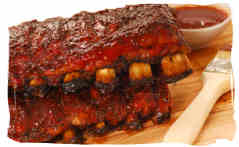|


Sure it's cold outside, however Spring is just around the corner. It will be time for getting outdoors and having great times.
We've not heard much from Smoky latey so we're going to
put him front and center. The following are a couple of
questions he has answered which we though you might
like to hear his barbecue'n logic.
 On the subject of briskets: On the subject of briskets:
Monty Oehrlein writes:
Smoky,
I have been a brisket cooker for years, and have cooked hundreds. I was taught, dare I say, to use the “Crutch”
Reading your thoughts, I am motivated enough to try a different approach. It is hard to even consider, as I have had a lot of success, both in contests, and with family and friends. In short, a lot of happy customers who can’t wait to get more!
I have a large offset smoker and can control the temps very well. I have Oak and pecan or apple wood at times. I even used lump charcoal a few times as well. Usually I use a dry rub, and smoke fat side _down_ about 6 hours before one mopping and wrapping. About 5 hours later, I take them off and let them sit in a container for another two hours or so before serving.
I am going to burn down the wood as you have suggested next time. Your comments about the wood make a lot of sense. It also might help from getting a face full of smoke the few times I do open the smoker.
My question is about mopping. If I loose the “crutch”, how much does mopping really help several hours into the process? Is it necessary for a juicy/tender end result? If so, what would be the key mop ingredients? I also noticed that you cook yours with the fat side up. Does the fat cap really ‘baste the meat itself with out making it greasy? I also believe that mopping will add to the total cook time because of opening the smoker. How much longer should I expect to endure this process?
Any more of your thoughts or wisdom on the subject would be appreciated to help me loose the “crutch” and keep my brisket eaters happy!
Thanks,
Monty
Hi Monty,
In addition to adding flavor, mopping keeps the exterior moist longer. As you probably have experienced with a damp pot holder, heat is conducted much better by moisture. Therefore by cooking at lower temperatures and mopping, the exterior stays moist longer and transfers heat more effectively.
Personally, when cooking brisket, I use a dry rub and a mopping sauce which consists of the dry rub in a mixture of water, vinegar and maybe a little Worcestershire. But whatever should meld with the dry rub.
I trim the fat to not more than 1/4" thickness and will turn and baste/mop the other side several times during the cooking process. After you have established that you temperature is holding and the meat is cooking to your wishes, no need to baste more than 30 minute intervals for the first few hours. After than rest and let the pit to the work bringing the internal temperature up to 190°-200°.
After you remove, let it rest for 20 minutes before slicing.
I think you will like the results.
Have fun,
Smoky
 On the subject of rusty pits: On the subject of rusty pits:
With the new barbecue'n season just about upon us, now is the time to get your pit up and running smoothly.
Subject: Re: Rusty Pit!
Smoky,
I am enjoying the newsletters! After reading this recent one it comes to
mind that I need to do alot more prep work on my pit before the "heavy
cooking season" fires up. Do you have any tips on treating rust and/or
paint products for smokers and pits? You know how the firebox gets on top
after a full spring and summer. Any help would besides "buy a cover" would
be appreciated!
Kelly Ragland
Hi Kelly,
As Charlie said ashes and water make a caustic base - read "lye" - which
eats up iron. Best way is to clean out all the ashes, hose it down real
well and spray it with a mixture of 2 Tb. vinegar per gal of water. Let it
dry real well. Turn it upside down if you have to. Then try to keep the
moisture out.
If you use it 2-3 times per week, you won't have a problem.
Fun,
Smoky
On the subject of pork butts:
 I have really enjoyed reading your new book that I purchased back in the Spring. So much so that I tried cooking a pork butt like you suggested (dry heat, temp below 215°) in my Weber water smoker. Listed below is a summary of the cooking session. Could you comment on the extended cooking time and the condition of the meat after such a long cook time? One piece of your advice that I did not use was to baste the meat every 20 minutes. How would this have affected the cooking time, the cooking session and the end result of the meat? From reading your book, this may have been much more important than I realized if it effects heat transfer to the inside of the meat. Also my cooking time for Butts is always 1 1/2 hours or more per lb of meat instead of the 45 min/lb that you suggest. My target internal temp of the meat was 190°. I have really enjoyed reading your new book that I purchased back in the Spring. So much so that I tried cooking a pork butt like you suggested (dry heat, temp below 215°) in my Weber water smoker. Listed below is a summary of the cooking session. Could you comment on the extended cooking time and the condition of the meat after such a long cook time? One piece of your advice that I did not use was to baste the meat every 20 minutes. How would this have affected the cooking time, the cooking session and the end result of the meat? From reading your book, this may have been much more important than I realized if it effects heat transfer to the inside of the meat. Also my cooking time for Butts is always 1 1/2 hours or more per lb of meat instead of the 45 min/lb that you suggest. My target internal temp of the meat was 190°.
I attempted cooking a 4 1/2 lb Boston Butt using the new lump charcoal from Walmart and the southern succor dry rub from Smoke and Spice (my favorite pork dry rub). End result - terrible and I am not so sure why! Began with half a charcoal chamber filled with the lump charcoal and approx. 20 lit lump pieces and a lot of the pieces were very small. The 20 lit pieces were started in a chimney and they lit in no time, 5 - 10 minutes and they were grey! Put the lit pieces on top of the unlit and assembled the cooker using no water in the water pan and all bottom vents closed. The cooker temp at that time was 160° and it continued to rise till it hit 280°. At that time I closed the top vent to get the temp down to 260°. Once it hit 260°, I opened the top vent 1/3 open and put the butt on the top grate.
My target cooker temp was 210° so I had to keep the top vent only opened 1/3 to keep it there. Remember, I was not using any water in the pan. One note here, there was no visible smoke coming from the cooker at this time or at any time during the session. I have never cooked with the top vent less than fully open but was willing to do it this time as an experiment.
In 4 hours the temp of the meat got to 150° so I turned it and reinserted the thermometer on the other side of the meat where it now registered 143°. For 4 more hours the temp of the meat never went above 147°. When I poked the temp probe in different places in the meat, the outside seemed very tough but the color of the outside was a light brown, not black or charred. It is almost as if the outside layer of the meat was acting as an insulator, keeping the inside of the meat from getting any heat. I kept the cooker temp at 210° up till this point by leaving all bottom vents closed and the top vent 1/3 to 1/2 open. Finally, I added water to the pan, basted the butt with apple juice and opened the bottom vents and the top vent fully to get the temp to 260°+ in the cooker. Finally 2 - 3 hours later the meat temp got to 167° and it was tough as a horse's saddle.
Not much good for shredded pork sandwiches.
Smoky,what happened?
John
Hi John,
Ever had a bad hair day? Sounds like you had a bad butt day.
First, where were you measuring the temperatures in the cooker? If the thermometer wasn't at the meat level, it could not accurately show that temperature.
Second, have you tested the thermometer lately?
Third, the grill must have air leaks. If you completely closed the intake vent, it should have shut down. Closing the exhaust is a last resort response to uncontrolled burning. Somehow, you must make that cooker maintain the temperature that you want it to.
Fourth, the 4 1/2 lb. Boston butt, probably had the fat removed. It is the interspersed fat that makes this cut fall apart when cooked around 210 until it reaches 185+. Without the fat to melt out, it would be better to take it off at 160 and slice it.
Fifth, with the meat reaching 150 in 4 hours, it should have gotten to 185 within 3-4 hours had the temperature been maintained.
Sixth, slice and chop that meat really fine and sprinkle it with a finishing sauce and make sandwiches out of it.
Seventh, welcome to barbecue!
Eighth, try it again.
Have fun,
Smoky
|